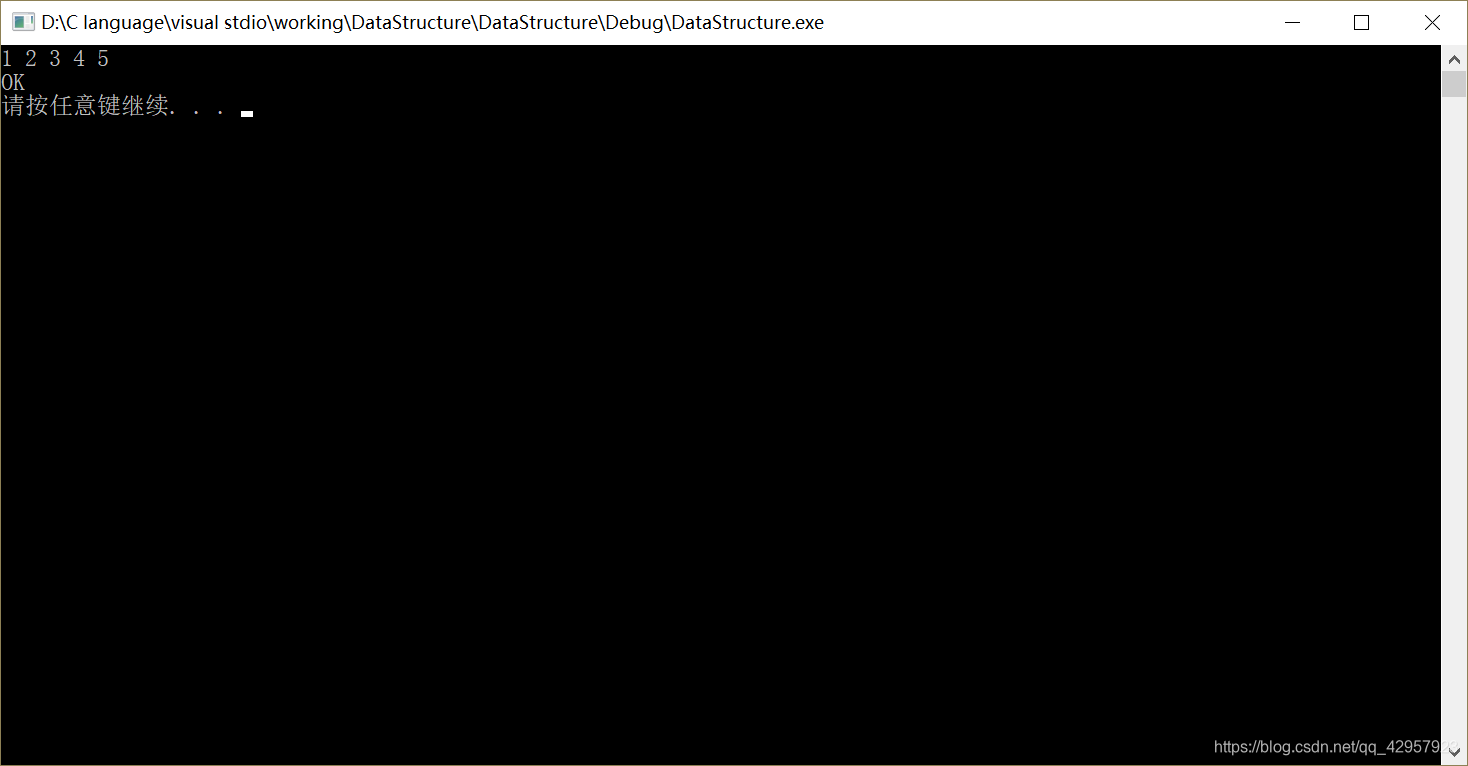版权声明:Sock的blog, 可以偷看但不可以偷走哦 https://blog.csdn.net/qq_42957923/article/details/85338784
链队列
用链表实现队列的基本操作, 定义两个指针, 分别指向链表的头结点和尾节点, 即作为队列的头和尾, 在队尾进行插入操作, 在对头进行出队操作
具体实现
定义一个链队列
//定义一个队列
typedef int ElemType;
//链表的定义
typedef struct QNode {
ElemType data;
struct QNode* next;
}QNode, *QueuePtr;
//队头和队尾指针的定义
typedef struct {
QueuePtr front;
QueuePtr rear;
}LinkQueue;
初始化链队列
//队列的初始化
void InitQueue(LinkQueue* L) {
L->front = (QueuePtr)malloc(sizeof(QNode));
if (!L->front) {
exit(0);
}
L->rear = L->front;
L->front->next = NULL;
}
链队列的入队操作
//入队列操作
int InQueue(LinkQueue* L, ElemType e) {
QueuePtr p = (QueuePtr)malloc(sizeof(QNode));
if (!p) {
exit(0);
}
p->data = e;
//从队尾入队, 其下一个结点为NULL
p->next = NULL;
//连接队列
L->rear->next = p;
//调整队尾指针, 使其始终指向队尾
L->rear = p;
return 1;
}
链队列的出队操作
//出队列操作
int OutQueue(LinkQueue* L, int* e) {
if (L->front == L->rear) {
//printf("队列为空\n");
return 0;
}
//定义一个调整指针来保存被释放的结点, 即队头的下一个元素
QueuePtr adjust = L->front->next;
//保存要出队的值
*e = adjust->data;
//如果出队后队列为空, 调整尾指针
if (L->rear == L->front->next) {
L->rear = L->front;
}
//连接队列
L->front->next = adjust->next;
free(adjust);
return 1;
}
队列的销毁
void destroyQueue(LinkQueue* L) {
while (L->front) {
//队尾指针始终指向队头指针的下一个元素
L->rear = L->front->next;
//释放队头结点
free(L->front);
//调整队头位置
L->front = L->rear;
}
//销毁后, 队头和队尾指针都为NULL
}
队列的清空
//清空一个队列
void ClearQueue(LinkQueue* L) {
//先将队尾指针指向队头指针的下一个结点
L->rear = L->front->next;
while (L->front->next) {
//队尾指针后移
L->rear = L->rear->next;
//释放队头指针和队尾指针中间的结点
free(L->front->next);
//连接队列
L->front->next = L->rear;
}
//队列为空时, 调整队尾指针
L->rear = L->front;
}
测试
#include <stdio.h>
#include <windows.h>
/*
用动态链表实现一个链队列
*/
//定义一个队列
typedef int ElemType;
//链表的定义
typedef struct QNode {
ElemType data;
struct QNode* next;
}QNode, *QueuePtr;
//队头和队尾指针的定义
typedef struct {
QueuePtr front;
QueuePtr rear;
}LinkQueue;
//队列的初始化
void InitQueue(LinkQueue* L) {
L->front = (QueuePtr)malloc(sizeof(QNode));
if (!L->front) {
exit(0);
}
L->rear = L->front;
L->front->next = NULL;
}
//入队列操作
int InQueue(LinkQueue* L, ElemType e) {
QueuePtr p = (QueuePtr)malloc(sizeof(QNode));
if (!p) {
exit(0);
}
p->data = e;
//从队尾入队, 其下一个结点为NULL
p->next = NULL;
//连接队列
L->rear->next = p;
//调整队尾指针, 使其始终指向队尾
L->rear = p;
return 1;
}
//出队列操作
int OutQueue(LinkQueue* L, int* e) {
if (L->front == L->rear) {
//printf("队列为空\n");
return 0;
}
//定义一个调整指针来保存被释放的结点, 即队头的下一个元素
QueuePtr adjust = L->front->next;
//保存要出队的值
*e = adjust->data;
//如果出队后队列为空, 调整尾指针
if (L->rear == L->front->next) {
L->rear = L->front;
}
//连接队列
L->front->next = adjust->next;
free(adjust);
return 1;
}
void destroyQueue(LinkQueue* L) {
while (L->front) {
//队尾指针始终指向队头指针的下一个元素
L->rear = L->front->next;
//释放队头结点
free(L->front);
//调整队头位置
L->front = L->rear;
}
//销毁后, 队头和队尾指针都为NULL
}
//清空一个队列
void ClearQueue(LinkQueue* L) {
//先将队尾指针指向队头指针的下一个结点
L->rear = L->front->next;
while (L->front->next) {
//队尾指针后移
L->rear = L->rear->next;
//释放队头指针和队尾指针中间的结点
free(L->front->next);
//连接队列
L->front->next = L->rear;
}
//队列为空时, 调整队尾指针
L->rear = L->front;
}
int main(){
LinkQueue L1;
InitQueue(&L1);
for (int i = 0; i < 5; ++i) {
if (InQueue(&L1, i + 1));
}
int e = 0;
for (int i = 0; i < 5; ++i) {
if (OutQueue(&L1, &e)) {
printf("%d ", e);
}
}
printf("\n");
destroyQueue(&L1);
if (!L1.front) {
printf("OK\n");
}
system("pause");
return 0;
}
效果图

希望本篇文章能对大家有所帮助, 真诚接受大家的评论和建议